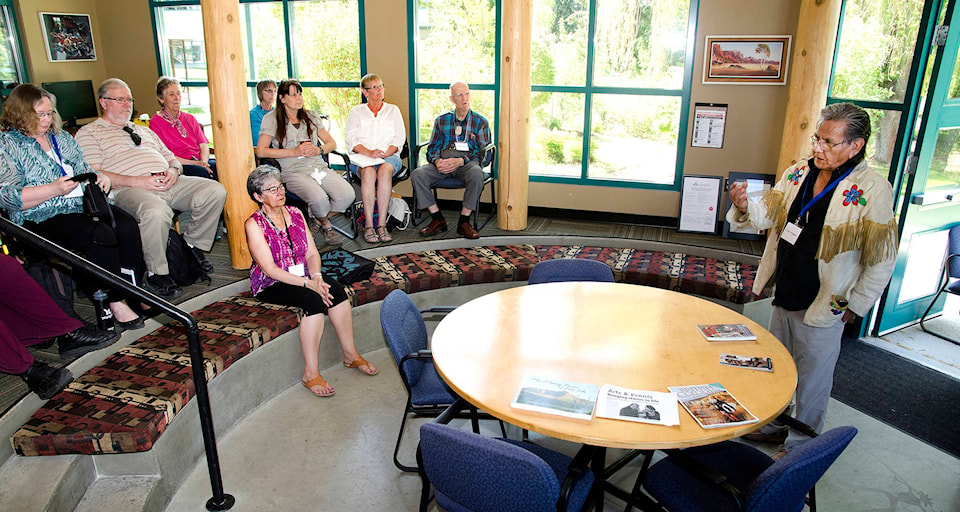Barb Brouwer
Contributor
A culture is often defined by its cuisine.
But Canada’s Indigenous people lost the right to their traditional food system with enactment of the Indian Act in 1876.
That cultural loss is something the federal government is now attempting to address in a project to learn about Indigenous food systems, revitalize key traditional food plants and look at ways to propagate them.
The $730,000 budget provided by Agriculture Canada and Agri-Food Canada (Ag Canada) will be split among two B.C. Interior bands, including Neskonlith, and two coastal bands.
Research scientist Mehdi Sharifi at the Summerland Research and Development Centre is the lead on the project that will include 13 scientists, two Ag Canada-industry liaisons, 10 non-Ag Canada members of academia and native plant nurseries.
Sharifi is clear that collaborative projects will be individually tailored to each of the four bands involved.
“We’re very excited to be co-developing this project with the Neskonlith,” says Sharifi, noting there are several reasons why Ag Canada is launching the project. “Basically it goes to the recognition and identity of Indigenous people and their rich culture.”
He says First People lived on and respected the land, something newcomers did not appreciate.
“They lost a lot of valuable resources and knowledge that they had, and it is extremely important that they are the people who are leading the movement toward self-identification and bringing back the culture, knowledge and traditions they lived with for thousands of years,” says Sharifi, noting that a flourishing First Nations culture benefits all society. “Because western knowledge has separated all the components, we can’t understand or do anything significant without collaboration. They need to be actively involved so it becomes meaningful.”
To Neskonlith counsellor Louis Thomas, the project is a long-held dream. He says, not only were Indigenous people forbidden by law to fish or hunt, they were unable to harvest food plants they gathered from as far away as Revelstoke.
Read more: Storytelling preserves Secwepemc culture, history in Shuswap
Read more: Salmon Arm meeting to begin new relationship for First Nations, local governments
Read more: Salmon Arm and Neskonlith partner for wildfire protection funding
“When the reserves were established, the European method of farming was introduced and Indians were told to grow potatoes, but they cut off the water and took away their ability to harvest the way they always had,” says Ruth Thomas, who will be the band lead on the three-year, pilot project.
“Our people stopped harvesting because it was easier to go to town,” says Louis, noting the change in diet led to an upsurge of diabetes among band members who had previously enjoyed a diet of fish, wild game, berries, fruits and herbs. “Our idea is to bring food sovereignty back to our people.”
Sharifi says a formal agreement between Neskonlith and Ag Canada is in the works and collection of maps and other information has already begun. He hopes to begin connecting with band elders and others in community, gathering more information and doing research in the fall.
Read more: Exhibit digs into food security, sovereignty and sustainability
Read more: Volunteerism in the spotlight at Salmon Arm community dinner
“Next year will be hard-core research, looking at maps, locating traditional plants and finding ways of propagating them,” he says.
And more help is at hand.
UVic masters student Libby Chisholm is working with Neskonlith and, with the help of Kenthen Thomas has established a small root garden on band land.
And Phil McIntyre-Paul, executive director of the Shuswap Trail Alliance, says a request to participate in the Indigenous food project by Louis and Chisolm was welcomed by the Shuswap Regional Trails Roundtable.
Using flash cards developed by the band, trail users will be able to use GPS to record the location of any of the traditional plants they spot.
“The roundtable is supporting this because essentially, like Louis says, it’s an extension of the caregiver role,” he says. “Part of working together is about taking care of the landscape.”
@SalmonArm
newsroom@saobserver.net
Like us on Facebook and follow us on Twitter
